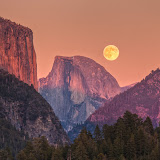
Select the photo above to visit the Picasa album: "HDRs in 2011 So Far"
HDR, "High Dynamic Range" photography has been around since at least 2003 when HDRsoft released Photomatix 1.0. It has become popular in recent years as some photographers try to overcome sensitivity limitations in digital sensors, and as other photographers use it to make their results look more dramatic. But will HDR succumb to a backlash, as over-saturated images did when Photoshop became widely used, or will it find a permanent place in photography's bag of accepted processes? That may depend on what your aspirations are. If you want to call your work "art" you can do what you want and see whether someone will pay you for it. If you'd love to work for National Geographic, you'd be wise to heed their requirements for their photo contests:
"Minor burning, dodging, and color correction are acceptable. High dynamic range images (HDR) and stitched panoramas are NOT acceptable." They go into more detail in their statement on digital manipulation.
As Ansel Adams developed his approach to photography, it had become very trendy for other photographers to hand-color their black and white prints. Color was new to photography, and the dramatic enhancement that color could add to an otherwise boring result gave many photographers a lot of attention. But over the long run, if a gimmick is what your'e relying on, and everyone has access to that same trick, your work will get lost in a sea of similarly altered results. How many of those photographers who clearly enhanced their photos do we know the names of today? Ansel Adams went in the other direction, working for hours in the darkroom to ensure that his artistic interpretations of a scene were presented in a realistic-looking way.
I've posted a lot of HDR photos to the new Google+ social networking platform recently to research how my use of HDR has changed over the past few years. I used it over 50% of the time in 2008 yet my Spring 2011 album shows the other side of the story, how my use of HDR has dropped below 5% as I follow Ansel's lead to pursue more realistic results. Time will tell whether history repeats itself and today's digital manipulations go the way of hand tinting, but I figure it's always useful to maintain skill in both the realistic and unrealistic camps, so at least whatever look you choose for a given image is a deliberate one, not simply the result that certain software imposes. I'd like to have enough control that I can compose images as an artist and share the light that I experienced, not spend my time as a technician, a captive to a limited repertoire of effects which fail to accurately convey the nature of the place and destroy the quality of that light!
Some people take a strong stance for or against HDR. My take on it is somewhere in between. Like many people I do get weary of seeing some of the most dramatic departures from natural-looking results now that the novelty of that look has worn off, but at the same time I find HDR useful in producing a small percentage of my images.
Some people have said that Ansel Adams surely would have embraced Photoshop and/or HDR, since his photos definitely did not seek to capture a simple reflection of how a scene looked when he saw it:
"You don't take a photograph, you make it."
On the other hand, as far as most viewers could tell, his results were plausibly realistic. Judging by his words, I think he would have certainly explored HDR, encouraged others to do the same:
"I hope that my work will encourage self expression in others and stimulate the search for beauty and creative excitement in the great world around us"
Ansel probably would have chosen to use HDR in a reality-supporting way, which may be new concept for some of the biggest proponents of HDR who advocate its more-than-reality potential.
Which direction should you choose? Sorry, I'm not a fan of "shoulds". I'd advise you to try a lot of different things, then choose your own path. But bear in mind if you enter photo contests that many of the most prominent photographers in the industry started in film, and some of them haven't even adopted digital yet. The over-saturation of Velvia film is fine with them, but they'll be turned off if they think you've applied even the exact same amount of saturation to a digital image. Typical results from HDR software could cause an even stronger negative reaction. Double standard? Sure. Just the way the world works sometimes? Absolutely. The bottom line is, do what you can, and when you develop a following of fans do what you want, keeping in mind the intended audience for your work.
If you've never tried HDR, you can download a copy of the latest Photomatix software to try at www.HDRsoft.com. Play around with it, and have fun! Search my blog for "technique tips" to see some my prior advice on how to prepare images for HDR processing.
If you decide to buy Photomatix HDR software, I do recommend the version with an interface to Lightroom and Photoshop, to give you the most control. You can get a 15% discount by using the coupon code JeffSullivan when you by it from its publisher HDRsoft: http://www.hdrsoft.com/order.php
Here are a couple of non-HDR images to show what you can do with standard image editing tools such as Adobe Lightroom:


Hello there sir, I also enjoy looking/watching nature and landscape photography. Do you have any blog for basic photogrphy? I want to learn more on photography. Thanks a lot.
ReplyDelete